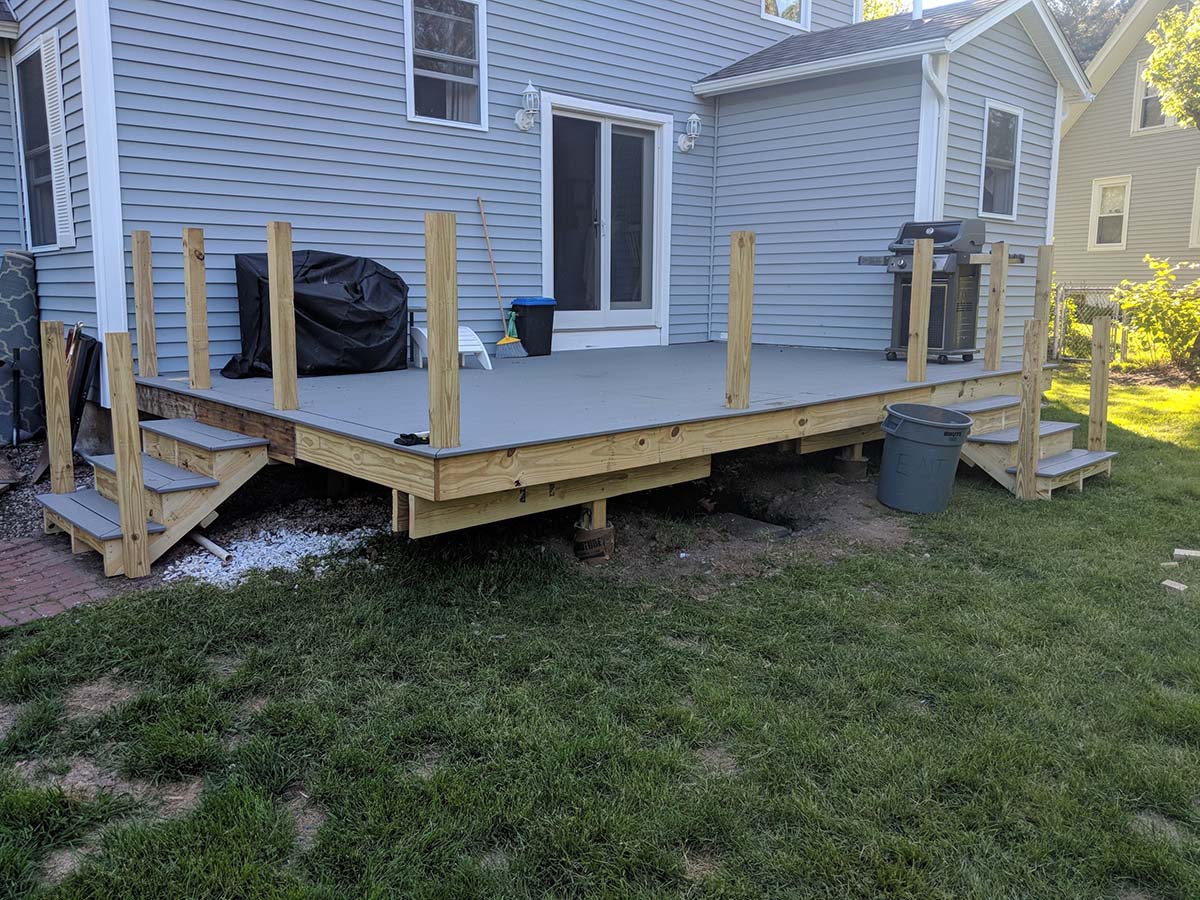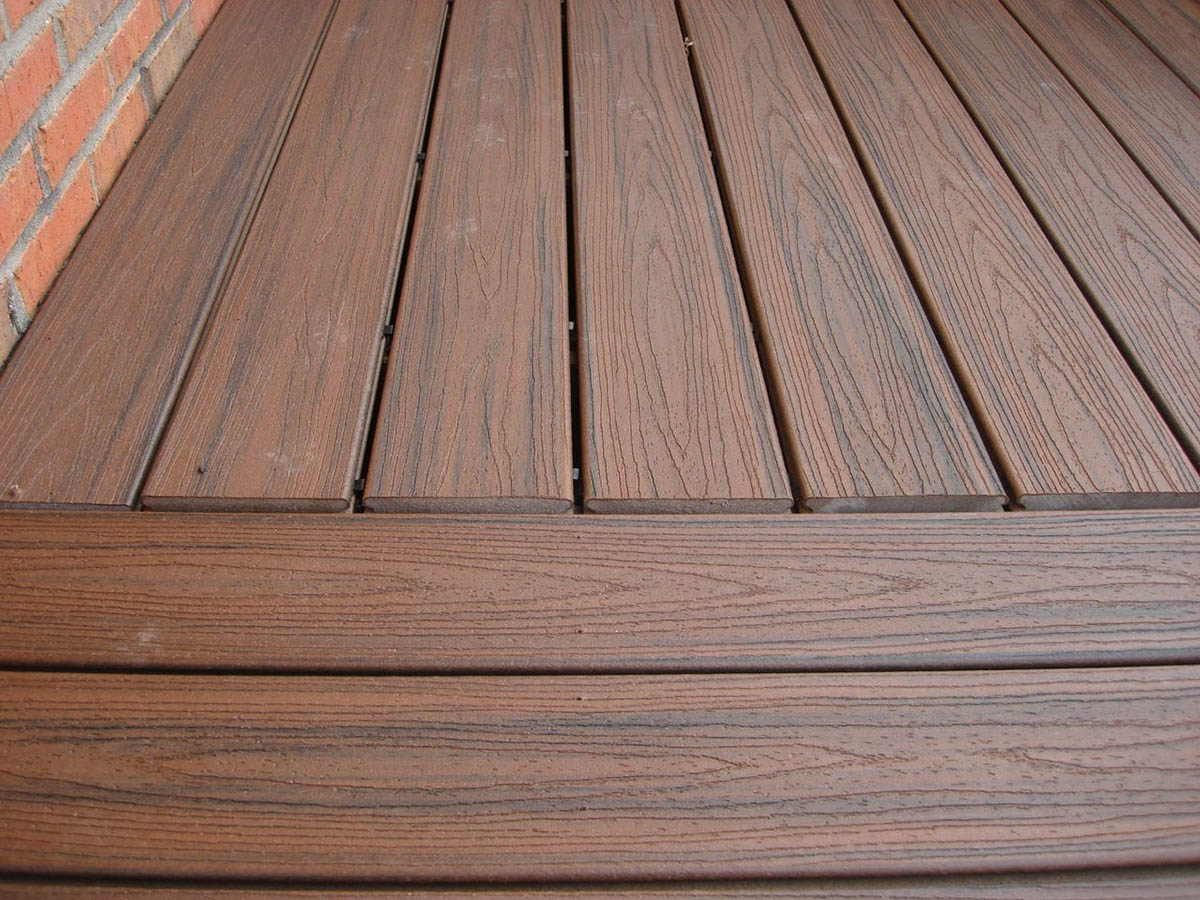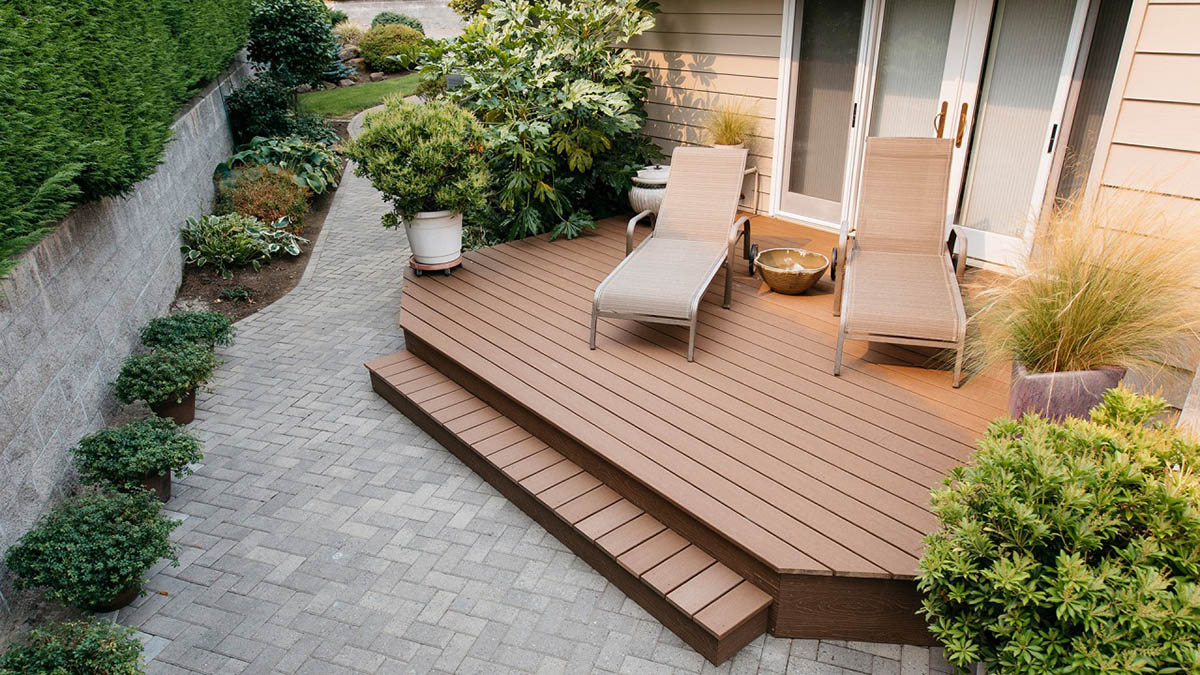Home>Furniture>Outdoor Furniture>How Far Can Trex Decking Overhang


Outdoor Furniture
How Far Can Trex Decking Overhang
Modified: August 27, 2024
Enhance your outdoor space with Trex decking and discover how far it can overhang. Create a stylish and functional area for outdoor furniture.
(Many of the links in this article redirect to a specific reviewed product. Your purchase of these products through affiliate links helps to generate commission for Storables.com, at no extra cost. Learn more)
Introduction
Welcome to our comprehensive guide on understanding and determining the overhang limits for Trex decking. Trex decking is a popular choice for outdoor spaces due to its durability, low maintenance requirements, and stylish appearance. When it comes to installing Trex decking, understanding the proper overhang distance is crucial to ensure both the structural integrity and aesthetic appeal of your outdoor furniture.
In this article, we will discuss the importance of Trex decking overhang, the factors that can affect overhang distance, recommended overhang limits, and installation guidelines for overhanging Trex decking. Whether you are planning a new deck installation or need to make adjustments to an existing one, this guide will provide you with the information you need to achieve a safe and visually pleasing outdoor space.
Before we delve into the details, it’s important to clarify what we mean by overhang in the context of Trex decking. Overhang refers to the distance that the deck board extends beyond the edge of the underlying support structure, such as the joists or beams. It is typically measured from the center of the last joist to the outermost edge of the deck board.
Now that we have a clear understanding of the concept, let’s explore why the proper overhang is vital for your Trex decking project.
Key Takeaways:
- Proper overhang in Trex decking is essential for a polished look, water management, safety, and structural integrity. It also accommodates thermal expansion and ensures compliance with building codes.
- Understanding overhang limits and installation guidelines is crucial for a successful and visually pleasing Trex decking project. Balancing functionality, design, and compliance with regulations is key to achieving a stunning outdoor space.
Read more: How Far Apart Are Joists For Trex Decking
Understanding Trex Decking Overhang
Trex decking overhang plays a crucial role in both the functionality and aesthetics of your outdoor furniture. Understanding the purpose and benefits of proper overhang will help you make informed decisions during the installation process.
The main purpose of overhang is to create a smooth and finished look for your deck. When the deck boards extend beyond the support structure, such as the joists, it eliminates the unsightly appearance of exposed edges. This gives your deck a more polished and professional finish.
Additionally, overhang helps to prevent water from seeping into the supporting structure of your deck. By extending the deck boards over the edge, any water or moisture that lands on the deck surface will run off and away from the underlying framework. This helps to prevent rot, decay, and potential damage to the structural integrity of your deck.
Furthermore, proper overhang also provides an added safety measure. Without overhang, the edges of the deck boards can become potential tripping hazards. Overhanging the boards ensures a smoother and safer surface for walking and prevents any potential accidents.
When calculating the desired overhang distance, it’s important to consider the specific attributes and requirements of the Trex decking material. Trex boards are composed of a composite material, which is a combination of wood fibers and recycled plastic. This composition gives Trex decking its durability, resistance to moisture, and low-maintenance properties.
However, it’s important to note that composite decking materials, including Trex, may expand and contract with temperature changes. This thermal expansion and contraction can affect the overall dimensions of the deck boards, including their length and width. Understanding this behavior is crucial when determining the appropriate overhang distance to allow for both expansion and contraction of the decking material.
Now that we have a solid understanding of the purpose and benefits of Trex decking overhang, let’s move on to exploring the factors that can influence the ideal overhang distance for your specific project.
Determining Overhang Limits
When it comes to determining the overhang limits for Trex decking, there are a few key factors to consider. These factors include the specific Trex decking product you are using, local building codes and regulations, and the overall design and layout of your outdoor space.
Trex provides specific guidelines for overhang limits based on their decking products. It is important to consult the manufacturer’s recommendations to ensure proper installation and warranty compliance. Generally, Trex recommends an overhang limit of 1 inch for their deck boards. This means that the deck boards should not extend more than 1 inch beyond the edge of the support structure, such as the joists or beams.
However, it’s important to note that local building codes and regulations may vary. It is essential to check with your local building department to ensure compliance with these regulations. They may have specific requirements for overhang limits based on factors such as the height of the deck, the type of railing system used, and the load-bearing capacity of the structure.
In addition to manufacturer and building code guidelines, the design and layout of your outdoor space can also influence the overhang limits. Factors such as the proximity to adjacent structures or landscaping features, the desired aesthetic appeal, and the intended use of the deck can all play a role in determining the appropriate overhang distance.
For example, if your deck is close to a wall or a fence, you may want to consider a smaller overhang to ensure a seamless and visually pleasing transition between the deck and the adjacent structure. On the other hand, if you have a deck that extends over a natural feature like a pond or garden, you may decide to have a larger overhang to create a dramatic effect.
Ultimately, the determination of overhang limits may require a combination of manufacturer recommendations, local building codes, and personal preferences. It is important to consider all these factors and find a balance that meets both functional and aesthetic requirements for your specific project.
Now that we have discussed the factors that can influence overhang limits, let’s dive deeper into the specific factors that can affect the overhang distance for your Trex decking.
Factors Affecting Overhang Distance
Several factors can affect the overhang distance for your Trex decking. Understanding these factors will help you determine the appropriate overhang distance for your specific project.
1. Decking Material: The type of Trex decking material you are using can influence the overhang distance. Different types of Trex decking may have different expansion and contraction properties, which can affect how much overhang is suitable. Be sure to consult the manufacturer’s guidelines for the specific decking product you are using.
2. Climate: The climate in your region can also impact the overhang distance. In areas with extreme temperature fluctuations, where the decking material expands and contracts more drastically, it may be necessary to reduce the overhang distance to allow for these movements and prevent undue stress on the deck boards.
3. Joist Spacing: The spacing between the joists can affect the overhang distance. If the joists are spaced wider apart, the deck boards may have less support, which could result in sagging or excessive movement. In such cases, reducing the overhang distance can help maintain the structural integrity of the decking.
4. Load-Bearing Capacity: The load-bearing capacity of your deck structure is another important factor to consider. If your deck is designed to bear heavy loads, such as furniture or large gatherings, it may be necessary to limit the overhang distance to increase stability and prevent any potential structural issues.
5. Deck Height: The height of your deck can also affect the overhang distance. Higher decks may require shorter overhangs to ensure proper weight distribution and reduce the risk of instability or structural failure.
6. Desired Aesthetic: The desired aesthetic appeal of your deck is a subjective factor that can influence the overhang distance. Some homeowners prefer a more streamlined and minimal look with minimal overhang, while others may opt for a more dramatic overhang to create visual interest and architectural appeal in the space.
Considering these factors and their specific impacts on overhang distance will help you determine the appropriate overhang for your Trex decking. It is essential to find the right balance between functionality, structural integrity, and design aesthetic to ensure a successful and visually pleasing outdoor space.
Now that we have explored the factors affecting overhang distance, let’s move on to the recommended overhang limits for Trex decking.
Trex decking can overhang up to 1 inch past the rim joists, but it’s best to follow manufacturer guidelines for specific overhang distances. Always use proper support and fastening methods for overhanging decking.
Recommended Overhang Limits
When it comes to the recommended overhang limits for Trex decking, it is important to consider the guidelines provided by the manufacturer, as well as any local building codes and regulations. These recommendations ensure proper installation, structural integrity, and compliance with safety standards.
Trex recommends an overhang limit of 1 inch for their deck boards. This means that the deck boards should not extend more than 1 inch beyond the edge of the support structure, such as the joists or beams. Adhering to this recommended limit helps maintain the stability and longevity of the decking system.
Local building codes and regulations may have specific requirements for overhang limits based on factors such as the height of the deck, the type of railing system used, and the load-bearing capacity of the structure. It is crucial to consult with your local building department to ensure compliance with these regulations and obtain any necessary permits for your decking project.
In addition to manufacturer and building code recommendations, it is also important to consider the specific attributes and requirements of the Trex decking material you are using. Different types of Trex decking may have different expansion and contraction properties, which can influence the ideal overhang distance.
Remember that the overhang distance should not only meet structural and regulatory requirements but also ensure a visually pleasing and functional outdoor space. Consider factors such as proximity to adjacent structures, desired aesthetic appeal, and intended use of the deck when determining the overhang limits.
Ultimately, finding the right overhang limit involves a balance between manufacturer recommendations, local building codes, material attributes, and personal preferences. By following these recommendations and considering all relevant factors, you can ensure a successful and well-designed Trex decking project.
Now that we have covered the recommended overhang limits, let’s move on to discussing the installation guidelines for overhanging Trex decking.
Read more: How Far Should Eaves Overhang?
Installation Guidelines for Overhanging Trex Decking
Proper installation of overhanging Trex decking is essential to ensure the structural integrity and longevity of your outdoor space. Following these installation guidelines will help you achieve a safe and visually pleasing result:
- Begin by carefully planning the layout of your deck, taking into consideration any desired overhang and the specific dimensions and shape of your Trex decking boards.
- Ensure that the supporting structure, including the joists and beams, is properly installed and meets all local building code requirements.
- Refer to the manufacturer’s guidelines for the specific Trex decking product you are using to determine the recommended overhang limit. This will ensure compliance with warranty requirements.
- Measure and mark the desired overhang distance on the supporting structure before installing the deck boards.
- When fastening the deck boards, ensure that they are securely attached to the supporting structure. Use appropriate deck screws or hidden fasteners recommended by Trex.
- For overhanging deck boards, make sure that the overhanging portion is properly supported. This may involve adding additional support blocks or joist reinforcement.
- Take into account the expansion and contraction properties of the Trex decking material when determining the final placement of the overhanging boards. Leave sufficient space for any potential movement.
- Closely follow the manufacturer’s guidelines for proper spacing between deck boards and any required end-to-end gapping. This will allow for proper drainage and ventilation.
- Once all the deck boards are installed, trim the overhang to the desired length using a saw or other appropriate cutting tools. Ensure a clean and straight cut.
- Inspect the entire deck surface for any sharp edges or protruding nails. Sand or file down any rough spots to create a smooth and safe finish.
- Lastly, clean the deck surface thoroughly and apply any recommended finishes or sealants to protect and preserve the Trex decking material.
Remember, it is always important to consult the manufacturer’s installation instructions and guidelines specific to the Trex decking product you are using. These guidelines may provide additional recommendations or considerations based on the unique attributes of the decking material.
Following these installation guidelines will help ensure a successful and visually appealing overhanging Trex decking project, providing you with a durable and stylish outdoor space for years to come.
Next, let’s explore the importance of proper overhang in Trex decking.
Importance of Proper Overhang
Proper overhang in Trex decking is crucial for several reasons. It not only enhances the overall aesthetics of your outdoor space but also ensures the structural integrity and longevity of your deck. Let’s explore the importance of proper overhang in Trex decking:
1. Aesthetics: Overhang creates a finished and polished appearance for your deck. It eliminates the unsightly exposed edges of the deck boards, creating a seamless and visually appealing surface. Proper overhang adds a professional touch to your outdoor furniture and enhances the overall look of your space.
2. Water Management: Overhang plays a vital role in managing water on your deck surface. By extending the deck boards beyond the support structure, it prevents water from seeping into the underlying framework. This helps to avoid damage caused by moisture, such as rot, decay, and mold growth, ensuring the longevity of your deck.
3. Safety: Overhang provides a safer environment on your deck. Without overhang, the abrupt ends of the deck boards can become potential tripping hazards. By extending the boards, you create a smoother and safer surface for walking, reducing the risk of accidents and injuries.
4. Expansion and Contraction: Proper overhang allows room for the expansion and contraction of the Trex decking material. Composite materials, including Trex, may expand and contract with temperature changes. By allowing for this movement, you minimize the risk of warping, buckling, or other issues that can arise if the deck boards are rigidly fixed to the support structure.
5. Structural Integrity: Overhang helps to distribute the weight and load evenly across the deck boards and supporting structure. It reduces stress on the joists and beams, ensuring a stable and sturdy deck. Without overhang, the unsupported ends of the deck boards may be more prone to sagging or bending under heavy loads.
6. Compliance with Building Codes: Following proper overhang guidelines ensures compliance with local building codes and regulations. Building codes often dictate specific requirements for deck overhang based on factors such as the height of the deck, railing systems, and load-bearing capacity. Adhering to these guidelines is essential to ensure a safe and compliant outdoor space.
In summary, proper overhang in Trex decking is essential for both functional and aesthetic reasons. It enhances the appearance of your deck, prevents water damage, improves safety, accommodates thermal expansion, and maintains the structural integrity of your outdoor furniture. By following the recommended overhang limits and installation guidelines, you can enjoy a beautiful, long-lasting, and safe Trex decking project.
Now, let’s conclude our comprehensive guide on Trex decking overhang.
Conclusion
In conclusion, understanding and implementing proper overhang in Trex decking is crucial for a successful outdoor furniture project. By following the recommended overhang limits and installation guidelines, you can achieve both functional and visually pleasing results.
Proper overhang enhances the aesthetics of your deck, creating a polished and finished look. It also plays a significant role in managing water, preventing damage caused by moisture and ensuring the longevity of your outdoor space.
Moreover, overhang promotes safety by eliminating potential tripping hazards and distributes weight evenly, maintaining the structural integrity of your deck. It accommodates thermal expansion and contraction of the Trex decking material, reducing the risk of warping or buckling.
By adhering to manufacturer recommendations, local building codes, and considering factors like climate, joist spacing, and desired aesthetic appeal, you can determine the ideal overhang distance for your specific project. Balancing functionality, design, and compliance with regulations is key to achieving a successful Trex decking project.
Remember to consult the manufacturer’s guidelines for the specific Trex decking product you are using and seek any necessary permits from your local building department to ensure a safe and compliant installation.
Proper overhang not only adds value to your outdoor space but also provides a beautiful and durable environment for entertaining, relaxing, and enjoying the outdoors. With the right overhang, you can create a stunning and functional outdoor furniture project that will be enjoyed for years to come.
We hope this comprehensive guide has provided you with valuable insights and guidance on understanding Trex decking overhang. Whether you are planning a new deck installation or making adjustments to an existing one, we wish you success in creating the outdoor space of your dreams.
Ready to turn your deck into a haven for relaxation and entertainment? Our next article, "Colorful Decor and Simple Add-Ons Ready This Deck for Outdoor Living," offers creative ideas to transform your space. Learn how simple additions and vibrant decor can create a perfect setting for your outdoor gatherings. Don't miss out on these practical tips to elevate your deck's appeal and functionality!
Frequently Asked Questions about How Far Can Trex Decking Overhang
Was this page helpful?
At Storables.com, we guarantee accurate and reliable information. Our content, validated by Expert Board Contributors, is crafted following stringent Editorial Policies. We're committed to providing you with well-researched, expert-backed insights for all your informational needs.















0 thoughts on “How Far Can Trex Decking Overhang”